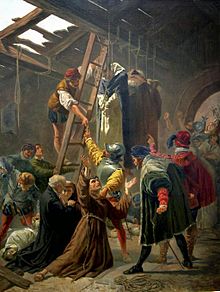This day in history: 19 Dutch Catholic clerics were hanged on this day (9 July) in 1572 in the town of Brielle by militant Dutch Calvinists during the 16th-century religious wars—specifically, the Dutch Revolt against Spanish rule, which developed into the Eighty Years' War.
It is easy to reflect on the bad things that Catholics have done throughout the ages, but when the tables were turned, the Protestants were often just as blood-thirsty. "During their imprisonment, the priests were tortured, subjected to countless indignities, and offered their freedom if they would deny the Real Presence of Christ in the Eucharist and the primacy of the pope. Despite a letter from Prince William of Orange ordering their release and protests from the magistrates of Gorkum, the men were thrown half-naked into the hold of a ship on July 6, and taken to Briel to be killed in the presence of a Protestant nobleman, Admiral Lumey, who was noted for his hatred of Catholicism. Their bodies, mutilated both before and after death, were callously thrown into a ditch." Source
Sabine Baring-Gould remarked on this in his Lives of the Saints: "The execution was done so carelessly that they were long in expiring. The cord supported one only by the chin, another had it in his mouth, and bit it like a bridle. Nicasius did not die till after the suu had risen. Before they were cold, the soldiers hacked the bodies and mutilated them in the most horrible manner. They fixed their noses, ears, and hands on their casques, or hung them over their pikes, and threw the bleeding morsels in the faces of the people who came to see the sight. The soldiers made the curious pay to enter the grange and feast their eyes on the horrible objects within. As the fat of those who have been hung was superstitiously believed to be useful in various diseases, the butchers cut up Jerome, who was fat, and extracted all the lard they could from his body, and sold it to quacks for the fabrication of unguents. On the roth, two ditches were dug, the bodies cast into them. There they remained till 1615, when they were exhumed and translated to Brussels. Portions of the relics have been given to many churches in Belgium."



No comments:
Post a Comment